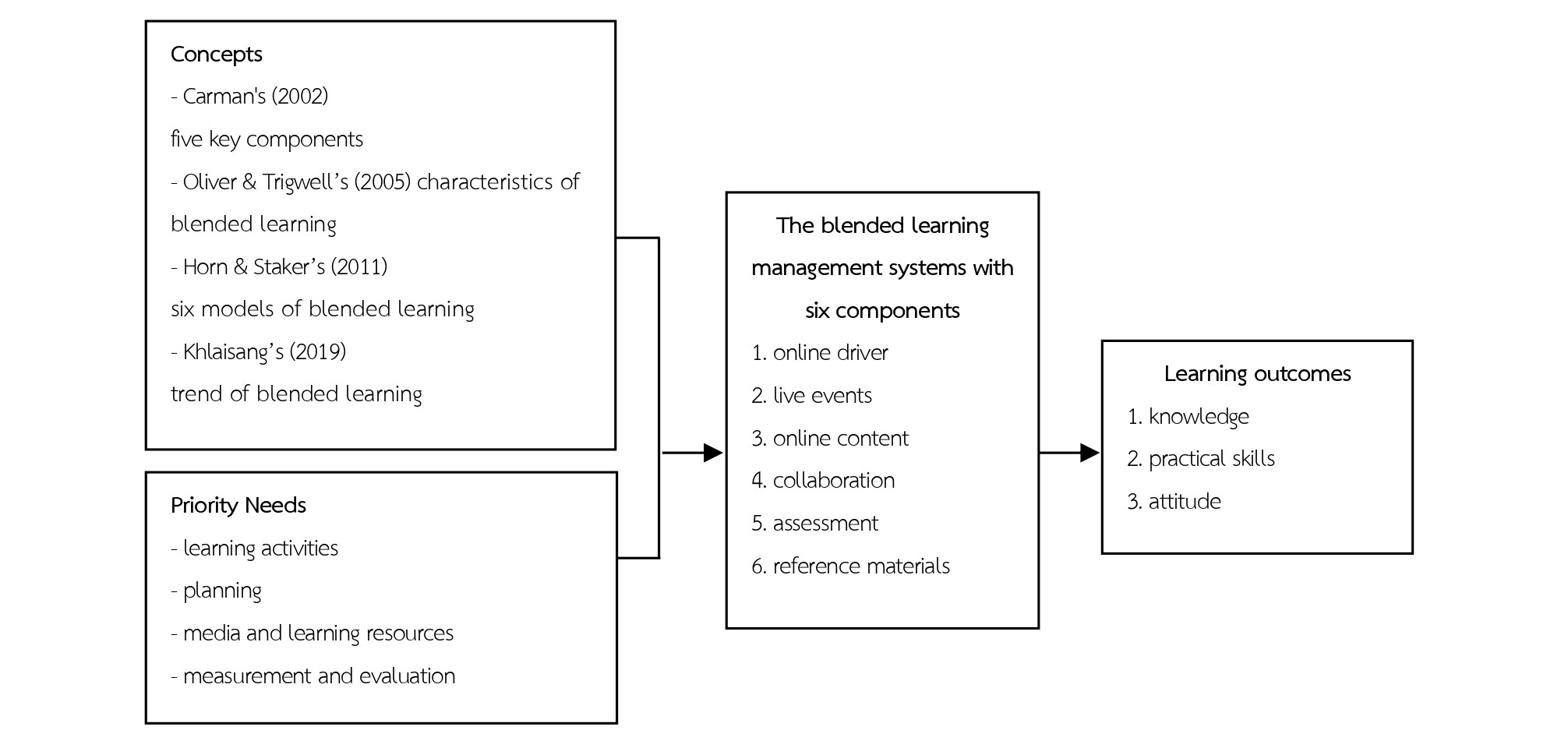Development of the Blended Learning Management Systems for Bachelor Degree Pre-service Teachers
DOI:
https://doi.org/10.14456/psruhss.2024.16Keywords:
Learning management system, Blended learning, Pre-service teacherAbstract
The main objective of this research was to develop a blended learning management system for bachelor degree pre-service teachers. This research was conducted in 4 phases as follows: Phase 1: studying the current conditions and the expected conditions of blended learning management. The sample group was 113 pre-service teachers undertaking a bachelor degree pre-service teachers in the Faculty of Education from five Public Universities in the northern region of Thailand. The research instrument used was a questionnaire. The data were analyzed using mean, standard deviation, and priority needs. Phase 2: developing the blended learning management system. The target group was five experts. The research instrument used was the blended learning management system propriety and feasibility assessment form. Mean and standard deviation were used for data analysis. Phase 3: Implementation of the blended learning management system. The sample group was 65 second-year pre-service teachers, majoring in Physical Education and Exercise Science, in the bachelor’s degree program in the Faculty of Education, Naresuan University. The research instruments used were as follows: a knowledge test, a practical skill assessment form, and an attitude test. The data were analyzed by percentage, mean, standard deviation, and t-test. Phase 4: evaluated certification of the blended learning management systems. The target group was five experts. The research instrument used was the certification evaluation form. Mean and standard deviation were used for data analysis.
The results revealed that: 1) The current conditions were at a moderate level and the expected conditions were at the highest level. The needs ranking were as follows: learning activities, planning, media and learning resource, measurement and evaluation, respectively. 2) The developed blended learning management system comprised of six components as follows: online driver, live events, online content, collaboration, assessment, and reference materials. The overall mean propriety and mean feasibility were at the highest level. 3) Generally, pre-service teachers had a mean learning outcome post-test of 84.02 (or 84.02%) higher than criteria 80% and higher than post-test of 63.11 with statistically significant at .01 level. 4) Evaluated the certification of the blended learning management system had an overall mean at the highest level and passed the certification.
References
Alammary, A., Sheard, J., & Carbone, A. (2014). Blended learning in higher education: Three different design Approaches. Australasian Journal of Educational Technology, 30(4), 440-454.
Carman, J. M. (2002). Blended learning design: Five key ingredients. N.P.
Deechai, W. (2019). Development the blended learning model to develop critical thinking and academic achievement of students in vocational education institutions (Doctoral of Industrial Education Thesis). Bangkok: King Mongkut’s Institute of Technology Ladkrabang.
Dziuban, C., Graham, C. R., Moskal, P. D., Norberg, A., & Sicilia, N. (2018). Blended learning: the new normal and emerging technologies. International Journal of Educational Technology in Higher Education, 15(3), 1-16.
Guzer, B., & Caner, H. (2014). The past, present and future of blended learning: an in depth analysis of literature. Procedia-Social and Behavioral Sciences, (116), 4596-4603.
Horn, M. B., & Staker, H. (2011). The rise of K-12 blended learning. N.P.
Khaisri, P. (2017). Development the instructional model using blended learning and metacognition for Faculty of Education Students in Rajabhat University in the Northeastern (Doctoral of Education Thesis). Bangkok: Dhurakij Pundit University.
Khlaisang, J. (2019). Documents for Academic Training on Blended Learning. Bangkok: Chulalongkorn University.
Kinto, M. J., Zhu, C., & Kagambe, E. (2017). Blended learning effectiveness: the relationship between student characteristics, design features and outcomes. International Journal of Educational Technology in Higher Education, 14(7), 1-20.
Kuder, G. F., & Richardson, M. W. (1937). The Theory of Estimation of Test Reliability. Psychmetrika, 2, 151-160. http://dx.doi.org/10.1007/BF02288391
Leaudnakrob, N. (2018). Development a blended learning model by organizing learning for change to promoting critical thinking abilities of nursing students (Doctoral of Philosophy Thesis). Phitsanulok: Naresuan University.
Oliver, M., & Trigwell, K. (2005). Can ‘Blended Learning’ Be Redeemed?. E-Learning and Digital Media, 2(1), 17-26. https://doi.org/10.2304/elea.2005.2.1.17
Singh, J., Steele, K., & Singh, L. (2021). Combining the Best of Online and Face-to-Face Learning: Hybrid and Blended Learning Approach for COVID-19, Post Vaccine, & Post-Pandemic World. Journal of Educational Technology Systems, 50(2), 140–171.
Wongwanich, S. (2007). Assessment of Learning Outcomes: New Approach (2th ed.). Bangkok: Chulalongkorn University.
Yamane, T. (1973). Statistics: An Introductory Analysis (3rd ed.). Massachusetts: Allyn & Bacon.

Downloads
Published
How to Cite
Issue
Section
License
Copyright (c) 2024 Humanities and Social Sciences Journal of Pibulsongkram Rajabhat University

This work is licensed under a Creative Commons Attribution-NonCommercial-NoDerivatives 4.0 International License.
Any articles or comments appearing in the Journal of Humanities and Social Sciences, Rajabhat Phibulsongkram University, are the intellectual property of the authors, and do not necessarily reflect the views of the editorial board. Published articles are copyrighted by the Journal of Humanities and Social Sciences, Rajabhat Phibulsongkram University.








